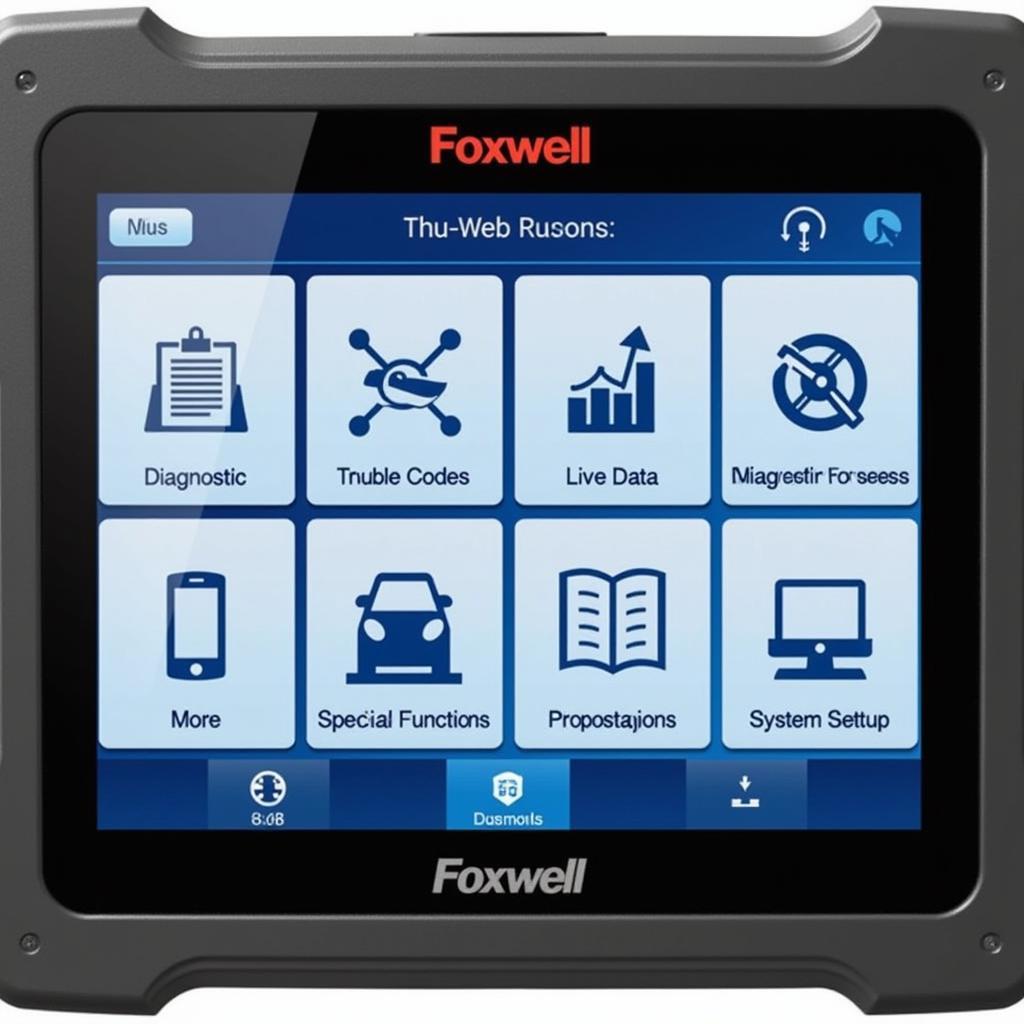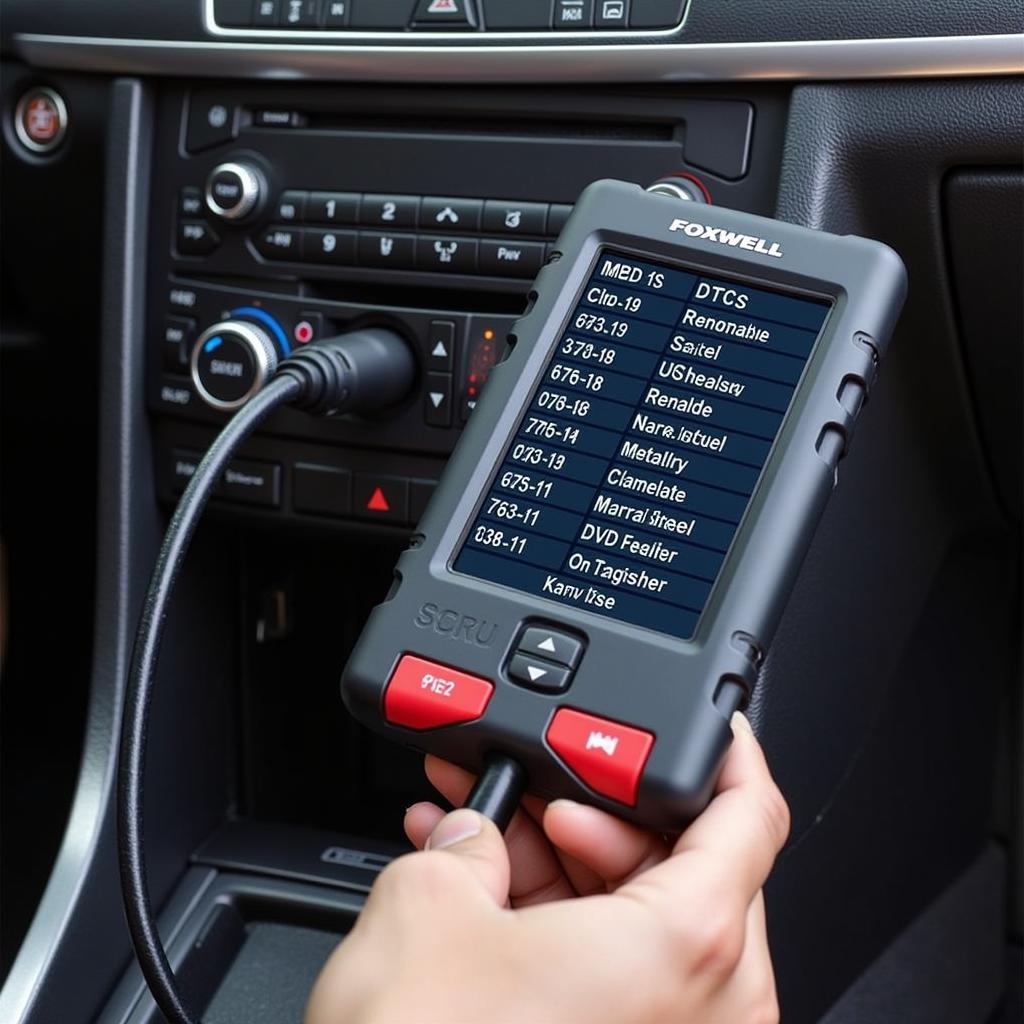The Foxwell NT301 OBD2 scanner is a powerful and affordable tool that can help you diagnose and clear trouble codes in your vehicle. Whether you’re a car enthusiast or a professional mechanic, knowing How To Reset Codes With Foxwell Nt301 can save you time and money on costly repairs.
This comprehensive guide will walk you through the steps of using the Foxwell NT301 to reset check engine lights, clear codes, and ensure your vehicle is running smoothly.
Understanding Diagnostic Trouble Codes (DTCs)
Before diving into the steps of how to use a Foxwell obd2 scanner, it’s essential to understand what Diagnostic Trouble Codes (DTCs) are and why they trigger the check engine light on your dashboard. DTCs are standardized codes that your vehicle’s onboard computer (ECU) generates when it detects a malfunction within a system.
These codes act as indicators, pointing to potential issues within the engine, transmission, emissions system, or other critical components. When a problem is detected, the ECU illuminates the check engine light, prompting you to investigate the issue.
Why You Might Need to Reset Codes
There are several reasons why you might need to reset codes using your Foxwell NT301:
- After Repairing the Underlying Issue: Once you’ve diagnosed and fixed the problem that triggered the check engine light, you need to reset the codes to turn off the light and confirm the repair was successful.
- Intermittent Issues: Sometimes, temporary glitches or sensor malfunctions can trigger false positive codes. Resetting the codes can help determine if the issue was a one-time occurrence or an ongoing problem.
- State Emission Testing: In many states, you need to pass an emissions test to renew your vehicle registration. If your check engine light is on, even for a minor issue, you might fail the test. Resetting the codes after addressing the problem is crucial for passing emissions.
Step-by-Step Guide to Reset Codes with Foxwell NT301
Follow these simple steps to reset codes using your Foxwell NT301:
-
Connect the Foxwell NT301: Locate your vehicle’s OBD2 port, which is typically located under the dashboard on the driver’s side. Plug the Foxwell NT301 scanner into the port.
-
Turn on the Ignition: Turn the ignition key to the “On” position without starting the engine. This powers up the scanner and allows it to communicate with your vehicle’s ECU.
-
Access Diagnostic Menu: The Foxwell NT301 will automatically power on and connect to your vehicle. Navigate to the “Diagnostic Menu” or a similar option on the scanner’s screen.
-
Select “Read Codes”: Choose the option to “Read Codes.” The scanner will communicate with the ECU and retrieve any stored trouble codes.
-
Record the Codes: Take note of all displayed codes. These codes provide valuable information about the potential issues affecting your vehicle. You can refer to the Foxwell NT301 user manual or online resources to decipher the meaning of each code.
-
Select “Erase Codes”: Once you’ve recorded the codes, navigate to the “Erase Codes” or “Clear Codes” option in the diagnostic menu.
-
Confirm Code Erasure: The scanner will prompt you to confirm the erasure. Double-check that you’ve addressed the underlying problem and then confirm to clear the codes.
-
Verify Code Reset: After the erasure process is complete, the Foxwell NT301 will confirm if the codes have been successfully cleared. In some cases, the check engine light might turn off immediately, while in others, it might take a few driving cycles for the light to reset.
Important Considerations
- Addressing Underlying Issues: While resetting codes with the Foxwell NT301 can temporarily turn off the check engine light, it’s crucial to remember that this action doesn’t fix the underlying problem.
- Battery Disconnection: Disconnecting the vehicle’s battery for a short period can sometimes reset the ECU and clear trouble codes. However, this method is not always reliable and can potentially erase valuable data stored in the ECU’s memory.
- Seeking Professional Help: If you encounter persistent trouble codes or are unsure about diagnosing and repairing car problems, it’s always recommended to seek assistance from a qualified mechanic.
Foxwell NT301: A Versatile Tool
The Foxwell NT301 is a valuable tool for any car owner. In addition to resetting codes, it offers various other features, including:
- Reading and Clearing Codes: The scanner can read and clear both generic and manufacturer-specific trouble codes, providing comprehensive diagnostics.
- Live Data Stream: The NT301 allows you to view real-time data from your vehicle’s sensors, such as engine RPM, coolant temperature, and oxygen sensor readings. This feature is helpful for monitoring sensor performance and identifying potential issues.
- Compatibility: The Foxwell NT301 is compatible with a wide range of car models, making it a versatile tool for both personal and professional use. You can find a list of Foxwell NT301 compatible cars on our website.
Choosing the Right Scanner
While the Foxwell NT301 is a popular choice, you might be interested in exploring other options. For instance, you can compare the Foxwell NT301 vs Autel AL619, another reputable OBD2 scanner, to see which one better suits your needs. If you’re a fan of Foxwell products, you can also check out our selection of Jan Foxwell scanners for more advanced features.
Conclusion
Knowing how to reset codes with Foxwell NT301 empowers you to take control of your vehicle’s maintenance and troubleshoot minor issues. This guide provided a comprehensive overview of the process, ensuring you have the knowledge to confidently reset codes and get back on the road. Remember, while the Foxwell NT301 is a powerful tool, it’s essential to address the underlying causes of trouble codes and seek professional help when needed.
For any questions or support regarding your automotive diagnostic needs, feel free to contact ScanToolUS at +1 (641) 206-8880 or visit our office at 1615 S Laramie Ave, Cicero, IL 60804, USA.


